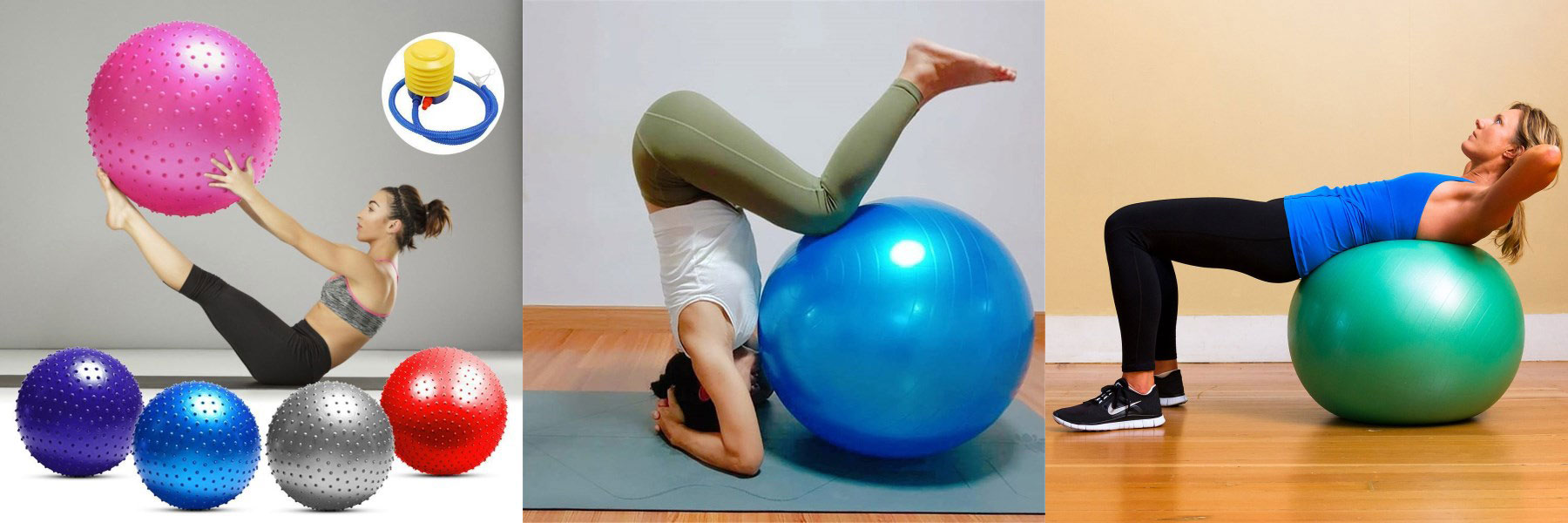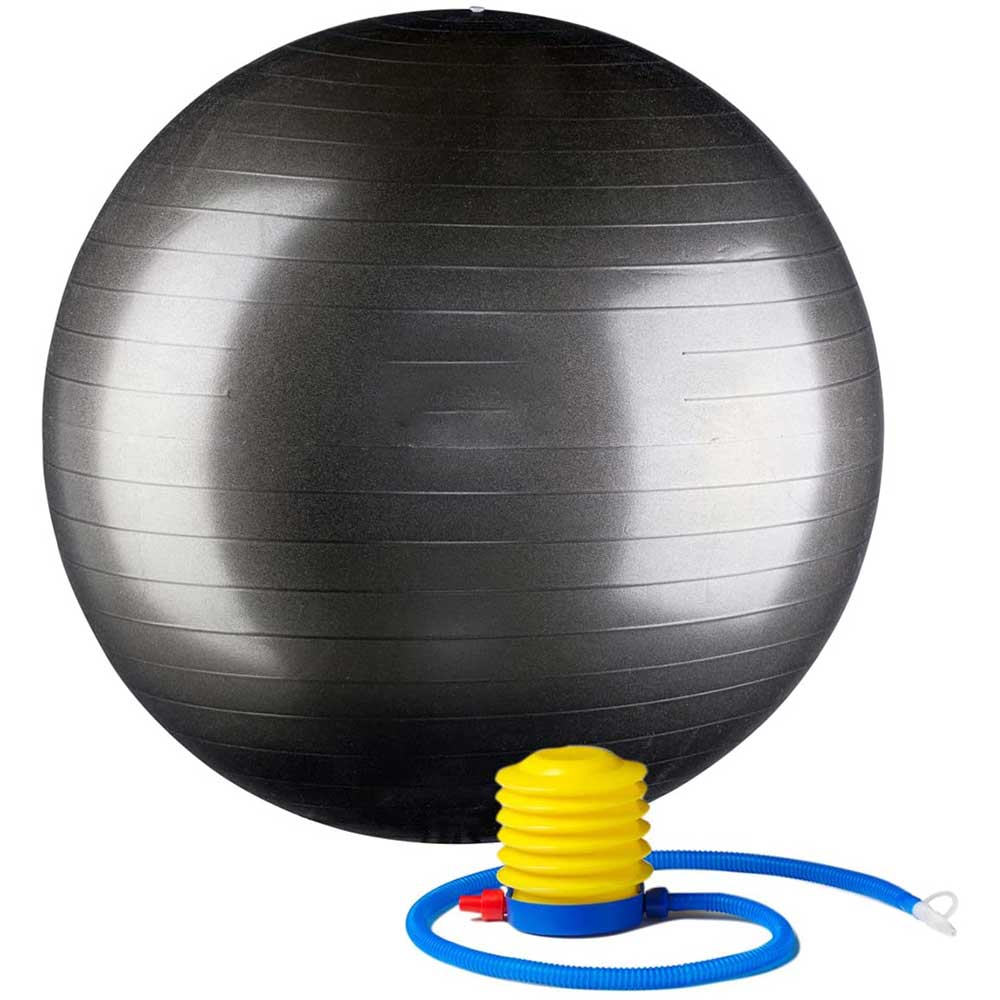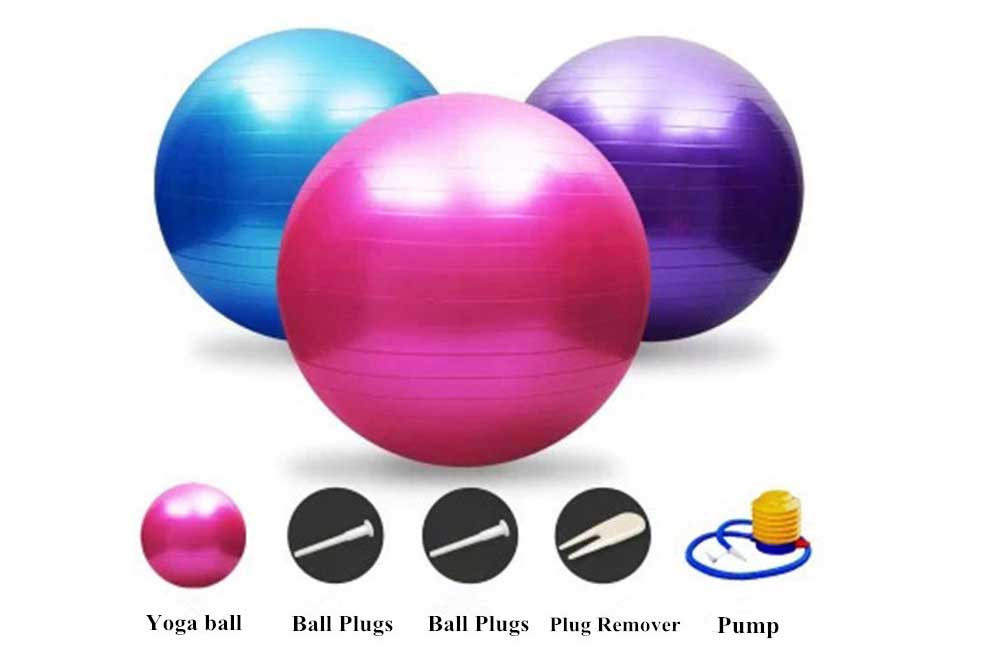Are you looking for a high-quality gym ball? To assist you, we offer this detailed guidance. Gym balls are highly compressed, heavy-duty inflatable balls that are used during exercise, they are also called Swiss balls, exercise balls, Pilates balls, physiotherapy balls, birth balls, etc. They vary in diameter from 18 to 30 inches (approximately 45 to 75 cm) and may be made of flexible vinyl or plastic. The stability ball has a good effect on your upper body, lower body and core. At the same time, Swiss Ball provides interesting and effective options for aerobics and strength exercises.
There are many different types, and choosing the right exercise ball is a challenge, but the following guide will answer most of your questions. Here, you will learn about the main features of fitness balls, control them when buying them, and other tips that can help you avoid low-quality products.
1. How does the material of the gym ball affect its properties?
Exercise balls are usually made of soft PVC, and other materials are also used, such as TPE, NBR and rubber. PVC balls are either made of recyclable materials or are environmentally friendly.
The environmental protection ball has a matte colour, is more elastic and more resistant to abrasion. On the other hand, recycled exercise balls seem to be a bit rough, have a strong smell and a more shiny appearance.
It is safe to make sports balls by using burst-resistant PVC with high elasticity and toughness. The thicker the PVC, the less likely it will explode during use. High-quality PVC can keep your ball in a good shape, even if you sit on it for a while, or use it in high-intensity training. It is a key component of the yoga ball plastic, which can make it swell and give it just the elasticity you need when using it in the gym.
Polyvinyl chloride (PVC) or polyvinyl chloride (polyvinyl chloride) also has an unmodified form, that is, the state after polymerization. However, this is still not suitable for use in exercise balls, so the use of additives makes PVC have some favourable modified properties. These additives can be anything, from flame retardants to heat stabilizers or impact modifiers.
Although rubber fitness balls are quite rare, some may contain latex. When buying a gym ball, be sure it is latex-free or you may be allergic to it. I have a client who is a smart lock supplier. She’s allergic to latex, so she can’t use an exercise ball that contains it. She has always trusted our exercise ball and recommended it to her other friends.
2. Which size gym ball should I choose?
There are many different sizes of exercise balls. These are suitable for people of different heights so that they can maintain proper posture during exercise.
The diameter of the stability ball is used to indicate its size. Fully inflate your stability ball and measure the diameter around the centre of the ball with a tape measure. The best size is determined by your height and the activities you plan to use the ball for.
Sit on an exercise ball as a chair. If your knees seem to be up and your thighs are at a lower level, you need a larger ball. Or, if your feet don’t touch the ground easily, you need a smaller exercise ball.
Appropriate Ball Sizes for Different Heights
|
Your Height |
Recommended Ball Size |
|
Below 5 ft |
45cm (mini fitness ball) |
|
5ft to 5ft 8in |
55cm (small fitness ball) |
|
5ft 9in to 6ft 2in |
65cm (medium fitness ball) |
|
Above 6ft 3in |
75cm (large fitness ball) |
We always recommend taking a larger ball in the following situations:
- Your legs are very long
- You are overweight
- Back problems
- You only need a stable ball to stretch
If your legs are shorter, or your BMI is lower, a smaller yoga ball will suit you better.
Want to know how to determine the size that suits you when shopping online? All you need is some tape measure and a little effort.
Squat with your back against the wall, your thighs parallel to the ground, and your knees bend at a right angle. Mark the wall at the height of your hips and measure the distance between the floor and this mark. This is a fully inflated ball with a diameter suitable for you!
However, before you get too nervous about the size of exercise balls, you should know that they are adjustable to some extent. If your hips and knees are at odd angles, you can always add or release some air to make it more suitable for you.
3. Does weight matter when buying a yoga ball?
Yes, you also need to control the weight of the yoga ball. Generally speaking, for the same big sports ball, always choose heavier. When buying a gym ball, ask the exercise ball manufacturer for its weight to understand its quality. Manufacturers that provide high-quality yoga balls usually mention weight in product specifications.

Fitness Gens
4. What are the factors that affect the anti-blast performance of exercise balls?
It is very common that all gym balls are marked with burst-proof or burst-proof labels. This means that you don’t have to worry about them bursting. If they are punctured, you can expect them to deflate slowly (and safely).
Better materials and sophisticated manufacturing processes are the keys to making an ideal burst yoga ball. For example, some Swiss balls have a honeycomb structure, and a lot of explosion-proof foam is produced on the surface of the ball. These bubbles can prevent any cracks or punctures from expanding further and avoid explosions. Others have added a keel-like explosion-proof function inside, which allows them to remain tough even under high pressure.
The thickness of PVC is an important factor in determining the quality of your sports ball. The thinner the ball, the lower the quality, and the greater the risk of bursting during use. Always choose thicker PVC balls to ensure safety and maximum durability.
Before buying a gym ball, it is best to test its burst resistance. Your safety while using this device is essential. A slowly shrinking ball is always the right choice, not a ball that explodes under you to prevent accidental punctures!
One thing to keep in mind is that in some cases, the ball marked “Explosion Proof” can also break. This is why you should check for any signs of wear before starting each exercise. Clean the ground to make room for your exercise ball, put away things that might hurt you when you fall, and use the exercise ball only indoors.

Office Clerk
5. What are the anti-slip properties of sports balls?
The anti-slip properties of the stabilizer ball are essential to prevent slipping accidents during use. The non-slip design of the ball will provide better control and is generally safer to use.
The texture of the sports ball can reflect its non-slip performance. What you need is to be able to move smoothly during exercise, but still provide enough grip to stay in place. The super-smooth surface can cause the ball to slide around dangerously during use. However, fabrics that are too viscous will quickly become soiled by cotton wool, hair and dirt while avoiding sliding.
6. What is the weight limit for exercise balls?
Different fitness balls can bear different weights. The limits of the body ball to bear static weight and moving weight is different. When the weight of a stable ball does not exceed it, the maximum weight it can support is its static weight limit. The maximum moving weight that a physical ball can support without exploding, such as the maximum weight that a person can bear when moving with it, is the weight limit.
The weight of most balls is limited to around 250 pounds or 113 kilograms. However, heavier balls may have a static weight limit of up to 2200 pounds and a weight limit of about 500 pounds.

Women Fitness
7. How durable are exercise balls?
If you decide to buy a ball that will remain in good condition after multiple uses, you should avoid thin, fragile balls. Choose a thicker material.
The availability of stability balls is also limited. Most manufacturers do not recommend using it after one year but recommend throwing it away.
8. What are the techniques techniques for inflating sports balls?
Before you start using the exercise ball, you need to inflate it properly. Although some balls have a pump, most of them are not good. This means you have to inflate the ball yourself.
You can use an air compressor or bicycle pump to inflate the exercise ball yourself. Make sure you fill them with the correct diameter, as described in the description. Some brands of exercise balls shouldn’t expand completely as soon as they are taken out of the box. They need to be stretched a bit, so we recommend filling a new ball with 80% air, overnight, and adding the remaining air the next day.
Here is the easiest way to judge whether you have enlarged the ball to the right size:
- Use a pencil the size of a fitness ball to mark the wall. For example, if your ball should have a diameter of 65 cm, make a mark on the wall 65 cm from the ground.
- Place the ball next to the wall you marked to inflate. Keep adding air until the top of it matches your pencil mark.
- Make sure you sit on the ball and blow it just right-the ball will sink two to three inches under your weight.
9. How long can the gym ball keep its shape without needing to be inflated again?
Over time, it’s not uncommon for fitness balls to lose steam. This leads to the loss of its robustness and ultimately makes it unsuitable for use. A fitness ball can stay very well in the air for a long time, which is a good thing, because it does not require frequent inflation, and inflation can be a hassle.
It is difficult to say how far a stability ball can stay after it is fully inflated. You can expect a high-quality ball to not leak air during multiple exercises, but it still depends on the type of sport you use it and how long the ball is under pressure. In addition, environmental factors, such as the temperature and humidity of your gym, can also affect how long a ball can stay in shape.
10. Does the exercise ball smell?
Some yoga balls have a smell, some don’t. The smell of the yoga ball can be a good indicator of whether it is made of non-toxic or safe materials. High-quality materials usually don’t emit any odour. On the other hand, cheap toxic materials can give exercise balls a strong plastic smell. One way to understand the safety or toxicity of fitness ball materials is to pass its GS certification (TUV test).
11. Does the colour of the sports ball affect sports performance?
Although this question may seem silly, it does have value because the answer is yes, it does! Psychologists have repeatedly reminded us how colour affects how you feel. Therefore, your emotions will affect your enthusiasm during the exercise.
We always recommend buying an energetic fitness ball to keep you active while you exercise. Dark or dark-coloured balls will slow you down, while bright balls will make you happy immediately.
12. What additional accessories does the fitness ball have?
Although the situation of each brand is different, some brands do provide additional accessories when buying exercise balls. These accessories usually include an air pump to inflate the ball, or further additional equipment, such as exercise belts, ball handles, tape measures, instructional videos, and ring frames.
If you want to inflate or deflate your ball frequently for storage, travel or other reasons, if possible, we recommend buying an electric air pump and a spare plug. This will make this process fairly simple for you, which can be a hassle for regular use compared to manual pumps or foot pumps.
13. What are the precautions for buying a fitness ball?
When buying a fitness ball, please keep the following in mind:
- Choose heavy PVC balls that are neither too slippery nor too sticky. Non-toxic, latex-free, professional standard PVC materials are always the best.
- Choose a sports ball that fits your height. Your feet should touch the ground, and when you sit on it, your thighs stay parallel to the ground.
- Ask the manufacturer for a video of the anti-burst test of the fitness ball. They should ensure that the ball is burst resistant. The small bubbles on the sports ball show the characteristics of explosion-proof, and after careful inspection, tiny particles may appear on the surface.
- Pay attention to whether it is difficult for you to pull out the plug of the exercise ball. The harder it is to pull it out, the better its tightness, and it can hold more air without leaking over a period of time.
- If you can, choose an electric pump, because manual and foot pumps are of low quality and very troublesome to use.
It is best not to inflate the ball completely all at once. Before being fully inflated, a partially inflated PVC ball should be allowed to rest and stretch overnight.
14. Conclusion
Fitness balls are difficult to choose. There are so many versions on the market, but knowing what to buy and what to avoid can make the choice easier. Now that we have answered the most common questions about fitness balls, you can buy them with your knowledge.
If you have any questions about yoga balls, please leave a message below and we will get back to you.






